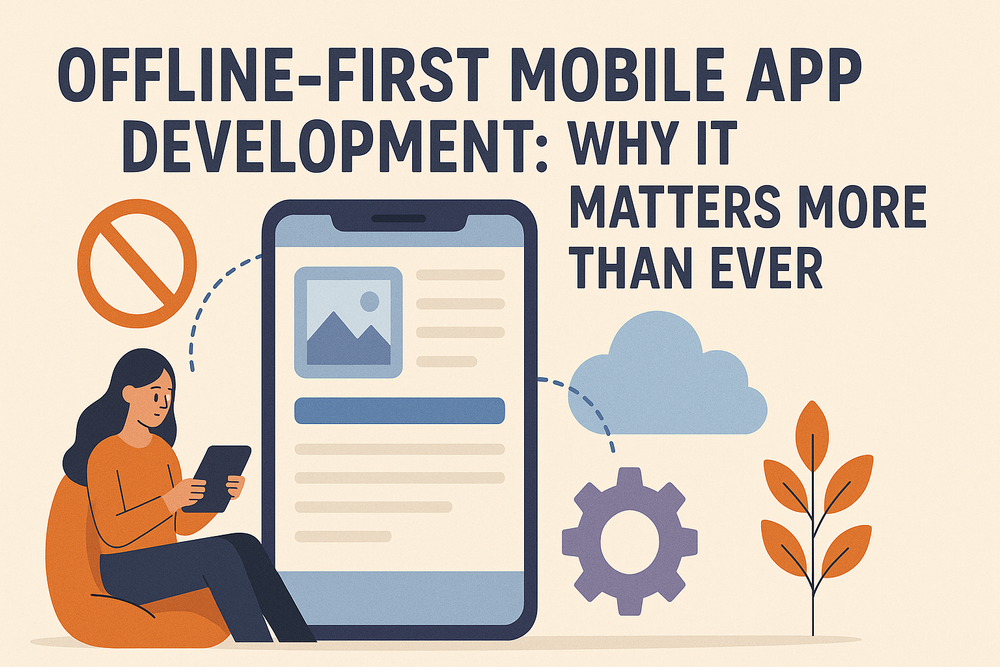Offline-First Mobile App Development: Why It Matters More Than Ever

In today’s hyper-connected world, we often assume that internet access is ubiquitous. However, unreliable networks, remote locations, and data restrictions still leave many users struggling with poor or no connectivity. This is where offline-first mobile app development comes in—a design philosophy that prioritizes functionality even without an internet connection.
What Is Offline-First Development?
Offline-first is an approach where apps are built to function primarily offline, syncing data with servers only when a connection is available. Instead of treating offline mode as an afterthought, developers design apps to work seamlessly regardless of network status.
Key Features of Offline-First Apps:
- Local Data Storage – Data is cached or stored locally (using SQLite, Realm, or IndexedDB).
- Background Sync – Changes made offline are synchronized once connectivity is restored.
- Conflict Resolution – Handles data conflicts when multiple users edit the same content offline.
- Progressive Enhancement – The app provides core functionality offline, then enhances features when online.
Why Offline-First Matters More Than Ever
1. Unreliable Connectivity is Still a Reality
Despite advancements in 5G and Wi-Fi, many regions suffer from:
- Spotty networks (e.g., subways, rural areas).
- High data costs (users may disable mobile data).
- Network congestion (events, emergencies).
An offline-first app ensures users aren’t locked out when connectivity drops.
2. Improved User Experience (UX)
Nothing frustrates users more than an app that fails when they need it most. Offline-first apps:
- Load instantly (no waiting for server responses).
- Allow uninterrupted workflows (e.g., note-taking, form submissions).
- Reduce dependency on server availability.
3. Better Performance & Efficiency
By minimizing server requests, offline-first apps:
- Reduce latency (data is fetched locally).
- Save bandwidth (fewer API calls).
- Extend battery life (less background network activity).
4. Business Continuity & Productivity
For enterprise apps (e.g., field service, healthcare, logistics), offline access is critical. Employees can:
- Update records in remote locations.
- Continue working during outages.
- Sync data automatically when back online.
5. Competitive Advantage
Users prefer apps that work anytime, anywhere. By adopting offline-first principles, businesses can:
- Increase engagement & retention.
- Expand reach to users in low-connectivity areas.
- Stand out against competitors with online-only apps.
How to Implement Offline-First in Mobile Apps
1. Choose the Right Data Storage
- SQLite (lightweight, embedded database).
- Realm (fast, object-oriented storage).
- Firebase Local Persistence (for Firebase-based apps).
2. Use Background Sync Strategies
- Queue & Sync Later – Store changes locally and sync when online.
- Conflict-Free Replicated Data Types (CRDTs) – Resolve merge conflicts automatically.
- Incremental Sync – Only sync changed data to save bandwidth.
3. Optimize for Offline UX
- Show clear offline/online status indicators.
- Allow users to retry failed actions.
- Preload essential data when online.
4. Test Under Real-World Conditions
- Simulate poor/no connectivity (using tools like Android’s Network Profiler or iOS’s Network Link Conditioner).
- Test sync behavior after reconnection.
Popular Offline-First Apps & Frameworks
- Google Docs (auto-saves offline, syncs later).
- Spotify (downloads songs for offline playback).
- Evernote (notes sync when back online).
- Firebase & Couchbase (support offline data persistence).
Conclusion
Offline-first isn’t just a fallback—it’s a necessity. As users demand seamless experiences regardless of connectivity, adopting an offline-first approach ensures your app remains functional, efficient, and user-friendly.
By prioritizing offline capabilities, developers can build more resilient, inclusive, and high-performing apps that stand the test of time—and spotty networks.
